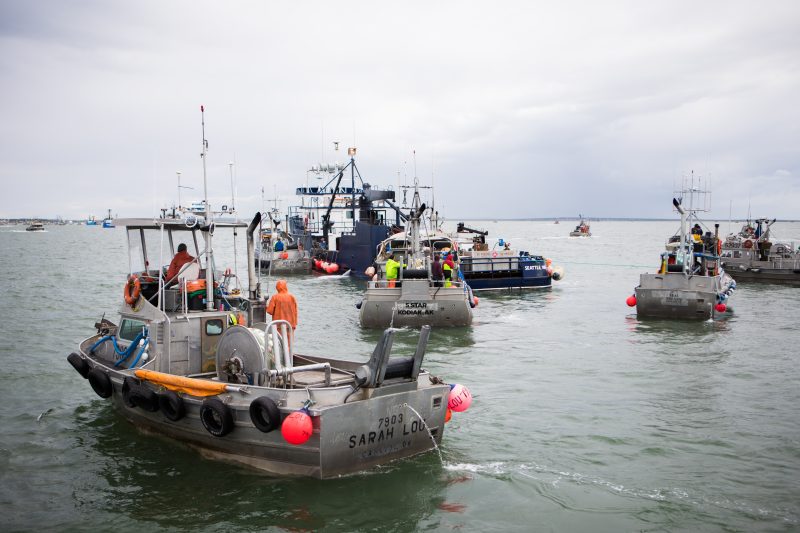America’s largest seafood producing state kept working through the covid-19 pandemic, but under difficult and constantly changing conditions. Seafood consumers were unable to eat out but became hungrier than ever for everything from king crab to Alaska pollock fish sticks to canned salmon. For at least nine months retail seafood sales were up 20-30 percent above pre-pandemic levels — a higher sales bump than all other parts of the grocery store. Those increases tell the story of high demand, but also of the hard work and sacrifice that kept boats fishing, processing lines operating, and shippers moving products to where they were needed.
To better understand how covid-19 is affecting the industry, the Alaska Seafood Marketing Institute commissioned McKinley Research Group (formerly known as McDowell Group) to produce a series of surveys and briefing papers.
Mitigation and Response Costs
Fortunately, Alaska’s winter/spring Bering Sea and Aleutian Islands fisheries were already underway when covid hit in early 2020, limiting initial impacts in those massive fisheries. Heading into the peak summer salmon season, processors and harvesters scrambled to set up new protocols and spent heavily to protect workers and communities. Sporadic outbreaks occurred, but fisheries that were once in question were widely heralded as successful.
Our research indicates that Alaska seafood processors spent roughly $70 million in 2020 to mitigate the spread of the virus through quarantines, chartered travel, and other measures. Seafood harvesters who responded to a separate ASMI survey reported spending an average of $9,350 per vessel on covid mitigation in 2020, while 82 percent said they expect covid-19 costs to be the same or higher in 2021. Uncertainty also resulted in fewer fishermen on the water. Crew license sales data from Alaska Department of Fish and Game show a 31 percent drop in commercial crew license sales from 2019.
Unfortunately, covid-19 cases exploded across the country at the end of 2020, just before the start of the 2021 winter/spring fisheries. Despite extensive precautions including prework quarantines, chartered travel and regular testing, several of Alaska’s largest seafood processors experienced outbreaks. Rapid responses and expanded vaccine distribution contained and mitigated the spread of the outbreaks. However, because of the high costs of bringing thousands of workers for these winter fisheries, as well as the response costs associated with outbreaks and mitigation measures that will continue throughout the year, the mitigation price tag for processors in 2021 is expected to exceed $100 million.
Relief Payments
The worst impacts of the pandemic were softened by government relief payments to businesses and individuals, but a patchwork of programs and inconsistency in access has left many processors, harvesters, and coastal communities struggling.
Roughly a quarter of harvesters that responded to our survey reported receiving relief payments (excluding the Paycheck Protection Program) that covered their pandemic-related losses, with another quarter receiving relief payments not meeting that threshold. Two-thirds of seafood processors reported receiving some covid relief (excluding PPP), but those payments only covered an average of 24 percent of pandemic impacts. And none of the processors reported it covered more than 35 percent.
The added costs extended beyond fishing vessels and processing plants. Expenses and logistical challenges piled up around the world for the seafood industry as the pandemic shifted consumer buying patterns and caused global cargo congestion. A particular challenge for the Alaska industry has been the covid-19 inspection protocols in the northern Chinese ports that are hubs for seafood reprocessing.
Revenue Impacts
The abrupt foodservice closures in March 2020 created an unprecedented shock, with many seafood sales channels disappearing overnight. Species that could transition to the grocery store, online, and drive-through restaurants did well. Other products more dependent on full-service restaurants and cafeterias suffered, including sablefish, halibut, Pacific cod, and flatfish, like flounder and sole.
Despite some species seeing strong prices in end markets, ex-vessel prices to fishermen were affected by higher costs, market uncertainty, and other factors. Preliminary data suggests Alaska’s catch was worth 20-25 percent less in 2020 compared to 2019. About half of that decrease was related to lower harvests (on top of covid, Alaska saw one of the lowest salmon runs since the 1970s) but lower prices also hit fishermen hard, with over 90 percent of harvesters surveyed reporting that covid-19 had a negative impact on the ex-vessel price they received.
Ongoing Effects
The operational challenges of covid-19 persist, and associated costs are stacking up to be worse in 2021 than in 2020. On the positive side, fishing is expected to be better thanks to a stronger salmon forecast and increases in some groundfish catch limits. Booming retail seafood demand did not make up for lost foodservice sales, but the pandemic helped accomplish strategic industry marketing goals of introducing more people to seafood and demonstrating how it can be easily prepared in the home. One thing is for sure: Alaska fishermen and processors will keep working hard to safely and sustainably meet the insatiable demand for wild Alaska seafood.








